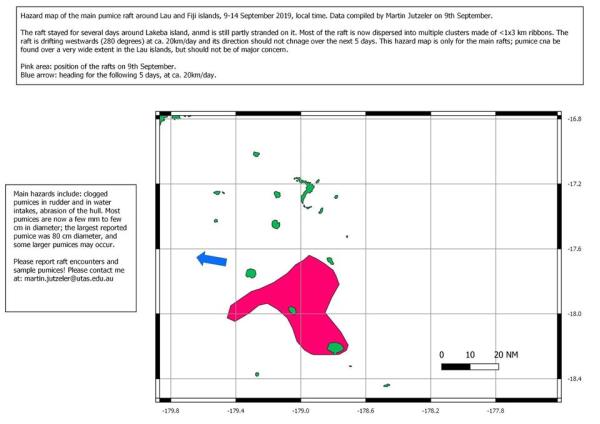By DariaBlackwell - 3 Sep 2019
It seems that underwater eruptions of volcanos can pose significant challenges to navigation. Most of us know about Kick 'em Jenny and how it affects buoyancy in the Caribbean. A recent vast raft of pumice in the Pacific is apparently not an unusual occurrence. It made me wonder if the pumice poses a hazard to navigation and what the actual ramifications could be. I imagine that small bits sucked into the saltwater intake could pose significant problems if the engine is running. Could there be an issue with the collision with the pumice or is it light enough and fluid enough to part without damage?
https://www.nytimes.com/2019/08/27/world/australia/pumice-raft-coral.html?te=1&nl=science-times&emc=edit_sc_20190903?campaign_id=34&instance_id=12084&segment_id=16678&user_id=b9a8dfbb204099e98df802eb0186aa4d®i_id=21860213
|
By Sandy.Garrity - 24 Nov 2019
Part of last summer's holiday reading was a book by John Voss written in the early 20th Centuary when he crossed that Pacific in a large dug out canoe and he mentiones pumice rafts then.
https://en.wikipedia.org/wiki/John_Voss_(sailor)
|
By DariaBlackwell - 24 Nov 2019
Sandy, that's cool. Thanks for the link which contains a link to the full text of the book online.
I should have posted a request from scientists for sailors to report sightings and collect samples to deliver once they reach Australia. Here it is. Contact info appears in the box on the left.
 . .
|
By sfoot - 25 Nov 2019
+x When the raft was first spotted, we understand that it was pretty well un-navigable as it was so huge and a metre or so deep. However, as you say, it is quite light and floats on the surface. Even when we came across it at beginning of October, there were still large chunks of it around (the size of a football pitch) but less than a foot thick. It doesnt do much to the paintwork and makes a nasty graunching sound. It is best to avoid if possible, but that isnt always possible (narrow channels or sailing at night) and in those circs it is preferable to sail through it and not motor. Cleaning out SW inlets to engine etc is essential. Our speedometer was constantly getting clogged.
|
By DariaBlackwell - 25 Nov 2019
+x+x When the raft was first spotted, we understand that it was pretty well un-navigable as it was so huge and a metre or so deep. However, as you say, it is quite light and floats on the surface. Even when we came across it at beginning of October, there were still large chunks of it around (the size of a football pitch) but less than a foot thick. It doesnt do much to the paintwork and makes a nasty graunching sound. It is best to avoid if possible, but that isnt always possible (narrow channels or sailing at night) and in those circs it is preferable to sail through it and not motor. Cleaning out SW inlets to engine etc is essential. Our speedometer was constantly getting clogged. Stephen,
If you logged the coordinates, please consider reporting them to the scientific group studying the pumice. martin.jutzeler@UTAS.edu.au
Thanks,
Daria
|
By sfoot - 25 Nov 2019
+x+x+x When the raft was first spotted, we understand that it was pretty well un-navigable as it was so huge and a metre or so deep. However, as you say, it is quite light and floats on the surface. Even when we came across it at beginning of October, there were still large chunks of it around (the size of a football pitch) but less than a foot thick. It doesnt do much to the paintwork and makes a nasty graunching sound. It is best to avoid if possible, but that isnt always possible (narrow channels or sailing at night) and in those circs it is preferable to sail through it and not motor. Cleaning out SW inlets to engine etc is essential. Our speedometer was constantly getting clogged. Stephen, If you logged the coordinates, please consider reporting them to the scientific group studying the pumice. martin.jutzeler@UTAS.edu.auThanks, Daria Hi Daria I am pretty certain that the scientific group knew the co-ordinates by the time we got there as we were getting warnings all the time from others as to its presence. Because the fields had broken up it was spread (in patches) over an area of a couple of hundred square miles- all along the N Coast of Viti Levu (Fiji) and including many of the fijian island chains out to the West. As soon as we headed S, we got away from it. Regards Stephen
|
|